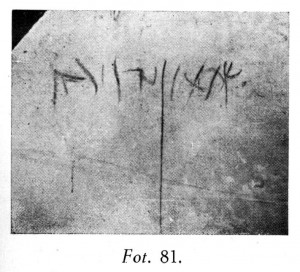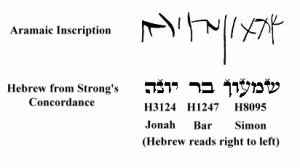
Pope Francis became the first Pope to descend into the necropolis in order to visit the doubtful tomb claimed for Peter. In ancient Roman paganism, an aedicula is a small shrine. The term “aedicule” derives from the Latin “aedes,” a temple building or house. Many aediculae were household shrines that held small altars or statues of the Lares and Penates. The Lares were Roman deities protecting the house. The Penates were patron gods or household gods. It was proximate to a pagan shrine like this that the bones of Peter were allegedly discovered. But it is not at all clear that the bones originated from there. The tale is quite suspicious. Catholic archeologist, Padre Antonio Ferrua, excavated a vast Roman cemetery that underlies St. Peter’s Square and basilica. According to his 1951 report, the excavations that had begun there in 1939 had unearthed a necropolis and some twenty pagan mausoleums but no trace of Peter. According to investigative journalist Tom Mueller:
“Ferrua and his colleagues had in fact worked with remarkable objectivity: despite intense pressure from the Vatican community, they reported no trace of Peter—not one inscription that named him, not even amid all the graffiti on his supposed tomb. Strangest of all, they discovered that the earth directly beneath the aedicula was empty.”[1]
Frustrated, Pope Pius XII demanded further research by Vatican loyal epigraphist, Margherita Guarducci. She inverted the previous findings, discovering drawings and inscriptions that Ferrua’s team had bizarrely overlooked after over a decade of investigation, including an inscription near the aedicula that she rendered as “Peter is within.” It is dubious that the original investigation reported nothing of the sort and innuendo and accusation still continue.
The grave that is now claimed by the Church to be that of St. Peter lies at the foot of the aedicula beneath the floor. In 1953, long after the initial twelve-year archeological effort had come up empty, another set of bones were found that were said to have been removed without the archeologists’ knowledge from a niche in the north side of a wall on the right of the aedicula. Subsequent testing indicated that these were the bones of a sixty- to seventy-year-old man. Meuller reported:
In the snarl of graffiti on Peter’s tomb she discerned a “mystic cryptography,” with countless coded messages about the Apostle. At length she even produced Peter’s remains. A sampietrino had shown her a wooden box of bones, she explained, which were inside the masonry surrounding the aedicula when the archaeologists first discovered it. Somehow they had overlooked the precious relics, and Monsignor Kaas later tucked them away for safekeeping. Scientific tests arranged by Guarducci indicated that the bones had been wrapped in a cloth of royal purple stitched with gold, and were those of a man of sixty to seventy years and a robust physique—the bones, she argued, of the Apostle.[2]
In other words, these bones were not even discovered at the actual site; rather, they were found in a storeroom and alleged to have been spirited away from the site. In addition to the human remains, the suspicious box contained sheep, ox, pig, and mouse bones. Most discrediting, there are no witnesses to place its origin at the site. This level of contamination makes the dubious discovery invalid by scientific standards. Who can say these bones were not simply planted by the demonstrably frustrated Vatican? This appears to be the case. Dr. Robert Beckford, a theology lecturer at Oxford Brookes University remarked, “We found that there is no scientific evidence to support the idea that Peter was buried in Rome, but yet the rival theory has not got out because it challenges the Church. If you undermine its basis for power you undermine the Church. It’s tragic that the faith gets reduced to manipulating the facts and to one Church trying to make itself superior to others.”[3]
Pope Pius XII stated in December 1950 that it could not be confirmed to be Saint Peter’s grave with absolute certainty. However, following the discovery of further bones and an inscription, much later in 1968, Pope Paul VI announced that the relics of St. Peter had been identified.
While there is no good reason to believe the Vatican’s evidence, scientifically rigorous archeological evidence suggests that Peter was not buried in the pagan capital. Over a century ago, a French Christian archaeologist, Charles Claremont-Gannueau, wrote a little-known report, dated November 13, 1873, from Jerusalem to the Palestine Exploration Fund. In this report he told of his monumental discovery. In a cave near Bethany in the Mount of Olives, a group of Jewish ossuaries (stone coffins) from the first century of the Christian era were found. To his great surprise, Claremont-Gannueau found that these ancient Jewish stone coffins contained the names of numerous individuals mentioned in the New Testament as members of the Jerusalem Church. Even more interesting were the signs of the cross etched on several of the ossuaries.
In John’s Gospel, we read, “Now a certain man was sick, named Lazarus, of Bethany, the town of Mary and her sister Martha” (John 11:1; emphasis added). The Mount of Olives was within walking distance of the ancient town of Bethany and the tomb discovered by Clermont-Ganneau contained names which correspond to the names in the New Testament. He discovered inscriptions including the names of “Eleazar” (“Lazarus”), “Martha,” and “Mary” on three different coffins. He also found inscriptions of the name “Yeshua” (“Jesus”) inscribed commemoratively on several the ossuaries. One coffin, also bearing cross marks on it, was inscribed with the name “Shlom-zion” followed by the designation “daughter of Simon the Priest.” Clermont-Ganneau wrote in his report:
This catacomb on the Mount of Olives belonged apparently to one of the earliest families which joined the new religion of Christianity. In this group of sarcophagi [coffins], some of which have the Christian symbol [cross marks] and some have not, we are, so to speak, [witnessing the] actual unfolding of Christianity. Personally, I think that many of the Hebrew-speaking people whose remains are contained in these ossuaries were among the first followers of Christ… The appearance of Christianity at the very gates of Jerusalem is, in my opinion, extraordinary and unprecedented. Somehow the new [Christian] doctrine must have made its way into the Jewish system… The association of the sign of the cross with written in Hebrew alone constitutes a valuable fact.[4]
The French archaeologist realized that there was a high degree of probability that these tombs belonged to the family of Mary, Martha, and Lazarus, the close friends of Jesus. Claremont-Gannueau wrote further, “By a singular coincidence, which from the first struck me forcibly, these inscriptions, found close to the Bethany road, and very near the site of the village, contain nearly all the names of the personages in the Gospel scenes which belonged to the place: Eleazar (Lazarus), Simon, Martha…a host of other coincidences occur at the sight of all these most evangelical names.”[5] Despite its monumental historical importance, this report was mysteriously never mentioned in the newspapers of the day. As a result, it was virtually lost to history.
Several years later very close by on the Mount of Olives, another by archaeologist, P. Bagatti, found and excavated another catacomb holding one hundred ossuaries. Based on inscribed crosses, the Chi Rho symbol, and the name “Yeshua,” Baggati concluded that these were also Jewish followers of Jesus Christ. Coins minted by Roman Governor Varius Gratus (AD 16) proved that these tombs were used for burial of Christians before the fall of Jerusalem in AD 70. The ossuaries contained the following names inscribed on their sides, together with Christian symbols or the name of Jesus: Jonathan, Joseph, Jarius, Judah, Matthias, Menahem, Salome, Simon, and Zechariah. While many of these names appear in the New Testament records of the Early Church at Jerusalem, the most fascinating ossuary was the one inscribed with crosses and the name “Sapphira.” This is a very unique name which has not been found in Jewish literature of the period outside the New Testament passage Acts 5: 1. Luke recorded the death of this woman and her husband when they lied to God and the Church (Acts 5:1, 5–10). “But a certain man named Ananias, with Sapphira his wife, sold a possession…” This very unique name eliminates reasonable doubt that this was indeed the tomb of early Christians.

 [6]
[6]Of course, the most controversial find of all was a coffin bearing the unusual inscription “Shimon bar Yonah” which is the full name Jesus used in the Matthew 16:17, ironically the favorite proof text of the papists. It seems improbable that a three-term name could refer to any other than the apostle Peter. Compounding a fully intact name with the fact it was found in a Christian burial ground amongst probable New Testament contemporaries from the very time in which Peter lived, the evidence is very convincing. The archeology was also conducted with scientific rigor sorely lacking in the Vatican’s Rome effort. One marvels at the Vatican’s feigned indifference at what is likely one of most important archeological finds in Christian history. This blatant neglect of evidence can only be explained by their vested interest in maintaining the mythology of the papacy.
Unfortunately, the Vatican seems all too willing to deceive its faithful. According to F. Paul Peterson, a Franciscan monk who knew the archaeologist Bagatti:
“Father Bagatti told me personally that three years ago he went to the Pope (Pius XII) in Rome and showed him the evidence and the Pope said to him, ‘Well, we will have to make some changes, but for the time being, keep this thing quiet’.” In awe I asked also in a subdued voice, “So the Pope really believes that those are the bones of St. Peter?”
“Yes,” was his answer. “The documentary evidence is there, he could not help but believe.”[7]
It truly seems that the Vatican has sought to suppress this important archaeological find simply to preserve their legend that Peter was the first pope. Yet right before our eyes lays the greatest proof that Peter was never a pope in Rome. If he had been, it would have certainly been written in the New Testament. The traditions of Peter in Rome can only be traced back to the second century, yet the archeological evidence at the Mount of Olives traces right back to the time of apostles. This is highly suggestive that Peter was never a pope in Rome and Pope Francis is perpetuating the lie of his predecessors.
Logos Apologia